For Greg Hays, cemetery sexton at Loveland Burial Park/Lakeside Cemetery in Loveland, Colorado, having a mower that easily moves between markers saves more than time—it saves the city money.
“The city is responsible for the headstones, which can average between $2,000 and $3,500 apiece,” Hays explains. “If we chip one of the tablets with the mower deck, in all likelihood the monument will have to be replaced. With millions of dollars worth of markers here, we have to be very careful.”
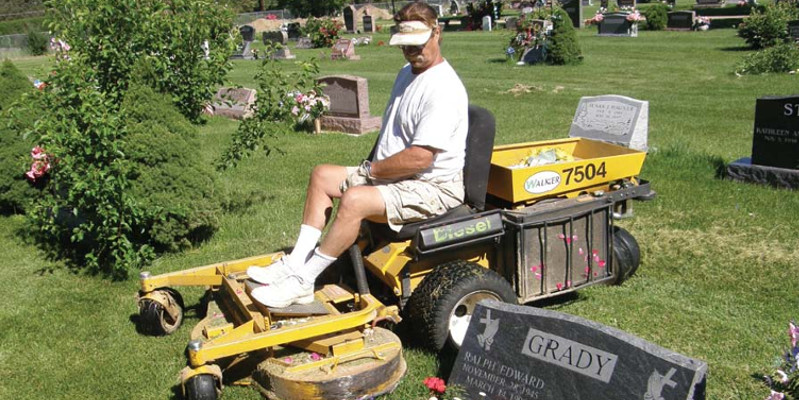
The maintenance crew also has to be fast. The 47-acre cemetery features 39 acres of turf and 17,000 upright markers (along with personal plantings) to mow and trim around.
Hays began working at the 128-year-old cemetery in 1988 after operating a mowing company and later working two years for another cemetery. “The most rewarding part of this job is that you’re helping folks at what has to be the most difficult time of their lives,” Hays says. “They find solace knowing that you will be caring for their loved ones.”
Having compassion and understanding is only part of a rather extensive job description for this cemetery sexton. In a typical day, Hays and his staff will arrange and schedule burials, set up tents, sell grave sites, repair old sites, interact with monument companies, and monitor/repair the irrigation system. While the cemetery subcontracts-out tree care on the ash, maple, elm and blue spruce trees that inhabit the cemetery, it does handle weed control and other turf maintenance chores like mowing. Hays is also safety coordinator for the city’s parks department.
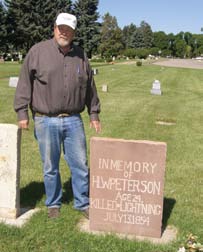 “When I came here 23 years ago, we were using old Marty J mowers—and they were old and worn out,” Hays explains. “In the process of looking for new equipment, I demoed a Walker Mower and instantly knew it was the perfect machine for the application.”
“When I came here 23 years ago, we were using old Marty J mowers—and they were old and worn out,” Hays explains. “In the process of looking for new equipment, I demoed a Walker Mower and instantly knew it was the perfect machine for the application.”
The cemetery initially purchased a couple of 16-hp, single-cylinder models before upgrading to 25-hp models later on, putting them on a four-year replacement schedule. Budget concerns was one reason the cemetery recently moved to diesel-powered Walker Model MDs.
Hays explains, “Fuel economy is important when you’re trying to cut costs, as is equipment longevity. Diesel engines get better fuel economy than their gas counterparts and will also outlive them, allowing the cemetery to extend the replacement period from four to six years. Equally important, diesel mowers have a higher trade-in value.”
“Not to say the gas models were a disappointment,” Hays quickly adds. “Those early 16-hp mowers had more than 2,500 hours on them when we traded them in, and they were in great shape. Gas or diesel, the key is preventive maintenance. Every night we blow off the mowers, grease them and check belt tensions. Every 75 to 100 hours, the park district will pick up the mowers to change the oil and perform other services recommended by the manufacturer.”
Left-Hand Turns
Featuring 52- and 62-inch sidedischarge decks, the Walker Mowers get a workout during the 26-week mowing season. It takes the crew 3-1/2 full days to mow.
“We get the deck as close to the markers as possible,” says veteran mower operator Kurt Stacey. “With the side-discharge deck, that means we make a lot of left-hand turns. Getting close reduces our time spent string trimming. Still, one person trimming all day long can hardly do the entire cemetery in a week.”
The trimming gets tedious, both Stacey and Hays admit, noting that in order to break up the monotony, the trimmer operator will log a few hours on a Walker Mower. Turning left all day long can be tedious, as well, so Stacey will alternate mowing around the monuments with mowing the flat marker sections. The cemetery has a grand total of more than 19,000 grave sites.
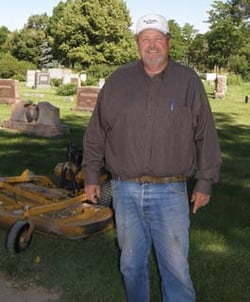 “Nothing beats the Walker Mower for this application,” Hays re-emphasizes. “I’ve demoed several mowers over the years, many of which dealers have touted for their speed. But I tell those dealers that it’s not just about speed, it’s about maneuverability and being careful.”
“Nothing beats the Walker Mower for this application,” Hays re-emphasizes. “I’ve demoed several mowers over the years, many of which dealers have touted for their speed. But I tell those dealers that it’s not just about speed, it’s about maneuverability and being careful.”
While driving around the grounds, Hays points to the scene of one of the first burials after being hired. “I wouldn’t have lasted very long if they were all like this,” he recalls. “It was raining the day of the funeral, and before the cemetery service was over the rain turned to snow. Our truck, backhoe and virtually every piece of equipment we had got stuck. It was a day to forget.”
Two elderly ladies pull up and inquire about the location of a couple of grave sites they just purchased. Hays points them in the right direction before crossing the main road with his Mule utility vehicle. “You know, I think we may be the only cemetery in the country to be split in two by a busy highway,” he points out. “This is the old section,” Hays says while pulling up to a site relocated to the cemetery several years ago. The marker reads that the individual was the victim of a lighting strike while on a cattle drive in the 1850s.
Back in the office, Sonya Andringa, office support specialist, is finishing up the paperwork on two recently sold grave sites while Pam Unfred, the city’s environmental education coordinator, is helping on a data entry project. She is transferring all of the documentation from hand-written records to a special software program that will allow visitors to easily find where loved ones and relatives are buried. In the near future, the cemetery will have a kiosk where visitors can key-in a name in order to get the grave location.
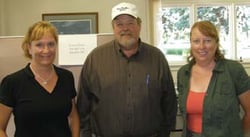 Hays admits that he never dreamed of being a cemetery sexton. “I went to school to be a teacher, and realized during my first day of student teaching that I wasn’t cut out for the job. I enjoyed owning my own mowing business and I enjoy this job. I enjoy the challenges and interaction with people. Plus, it’s gratifying to know that you’re doing something to help people out in their time of need.”
Hays admits that he never dreamed of being a cemetery sexton. “I went to school to be a teacher, and realized during my first day of student teaching that I wasn’t cut out for the job. I enjoyed owning my own mowing business and I enjoy this job. I enjoy the challenges and interaction with people. Plus, it’s gratifying to know that you’re doing something to help people out in their time of need.”



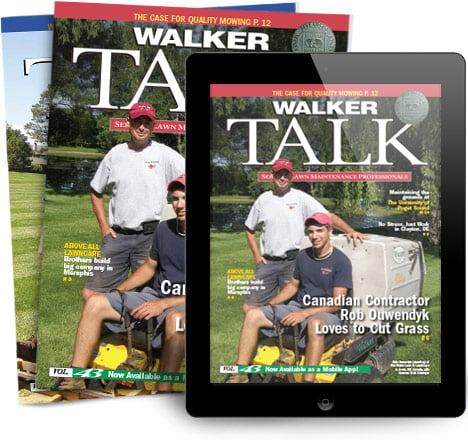
 Site Search
Site Search



